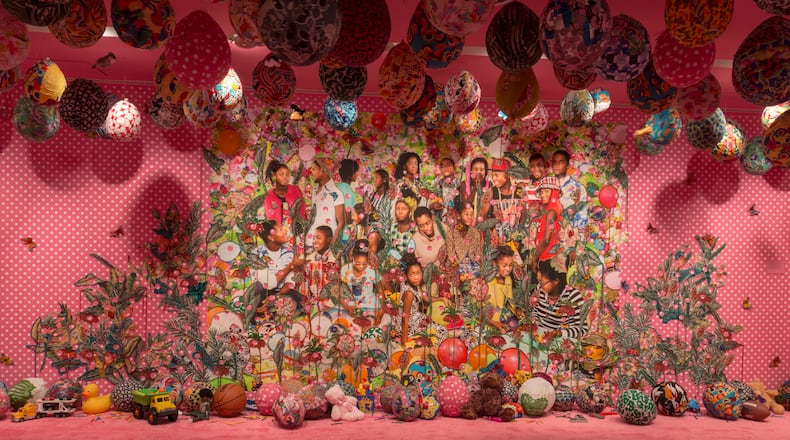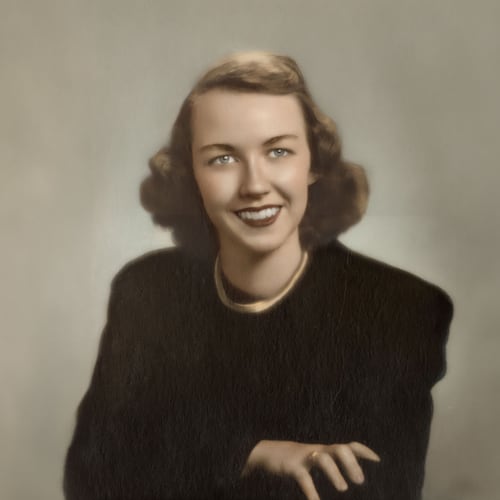The 98 artworks that make up “Giants: Art from the Dean Collection of Swizz Beatz and Alicia Keys” run the gamut from trenchant social commentaries to works of pure aesthetic pleasure.
This critically celebrated exhibition assembles the personal collection of musicians Keys and Beatz (Kasseem Dean). The show just wrapped at New York’s Brooklyn Museum of Art and opens Sept. 13 at the High Museum, its only stop in the Southeast.
“Giants” features some influential art history legends like Lorna Simpson and Barkley L. Hendricks, as well as up-and-comers like Deana Lawson, whose solo show debuted at the High in 2022.
Kimberli Gant, curator of modern and contemporary art at the Brooklyn Museum of Art and organizer of the show, has experience bridging Black art history and exciting new voices. Filmmaker Spike Lee’s collection, “Spike Lee: Creative Sources,” and a survey of one of American art history’s most prominent and influential artists, painter Jacob Lawrence, are among her past shows.
On a tour through the assembled works in “Giants,” Gant shared her thoughts on five key works that tease out some of the themes in the show — Black success and beauty, exceeding the limitations of one’s reality, social justice and the impact of violence.
Ebony G. Patterson
" . . . they were just hanging out . . . you know . . . talking about . . . (. . . when they grow up . . .)”
Chicago-based artist Ebony G. Patterson received the 2023 Driskell Prize at the High Museum in recognition of her contributions to African American art. Originally from Jamaica, Patterson is known for her bold, seductive colors and materials and her maximalist approach. Her mixed media works are layered with sequins, fabric, costume jewelry, artificial flowers, beads and other ephemera that turn ubiquitous, commonplace objects into potent memorials and celebrations.
Her 2016 installation “...they were just hanging out” is a complex interplay of joyous celebration and plangent memorial that addresses a cultural fear of youth, called ephebiphobia. That fear is especially damaging to Black children whose childhood and innocence are stripped away by fear and racism.
In her installation, Patterson evokes the kind of sidewalk memorials that commemorate a death with layers of stuffed animals, flowers and balloons. Photographs of Black girls, boys and teenagers are interspersed in Patterson’s multimedia work alongside exuberant shades of pink and busy polka dot patterns. Patterson has said the installation was inspired by an uptick in child murders in her native Jamaica, as well as violence against Black children who are presumed guilty on sight, like Trayvon Martin and Tamir Rice, by the adults who should be protecting them.
“She pulls you in with this beautiful spectacle of color and glitter and joy, and then goes, ‘but what happens when these children don’t get that?’” said Gant. “Will these children get the opportunity to grow up and fulfill these dreams and goals? These are children who want to hang out with their friends, who want to relax, enjoy it, have fun. But oftentimes they are not allowed to, or even when they are, they are still perceived outwardly as being a threat,” said Gant.
Credit: High Museum of Art / Glenn Steigelman
Credit: High Museum of Art / Glenn Steigelman
Jamel Shabazz
“Trio, Brooklyn, NYC”
In the early ‘80s, Brooklyn-born photographer Jamel Shabazz returned to New York from serving in the Army and was working as a corrections officer at the notorious Rikers Island prison. He began to photograph men and women on the streets and subways of New York that coalesced over time into a joyful celebration of the creativity, warmth and beauty of New York City life.
“I think he was going out to look for beauty in all of its forms and using the train seeing the different aspects of the city,” said Gant. Shabazz was after a different view of the Black experience than the often-unflattering visions offered by the culture at large. Young couples with their newborns, best friends, boom boxes, break dancing, Kangol hats, Adidas logos and the emerging hip hop culture of New York at that time lend a heady, transportive sense of nostalgia to his photography.
“I think we forget that there is such incredible energy and beauty, just in the mundane, in the day to day. And in New York in particular,” said Gant.
In “Trio, Brooklyn, NYC” (1980), three young men, all neatly dressed and wearing red, pose for Shabazz in a graffiti-covered subway car. There’s a degree of innocence and freedom in their easy smiles and relaxed body language that underscores Shabazz’s ability to put his subjects at ease. His familiarity with their world gives his images an intimacy like family portraits.
Credit: High Museum of Art / Joshua White / JWPictures.com
Credit: High Museum of Art / Joshua White / JWPictures.com
Toyin Ojih Odutola
“Paris Apartment”
Nigerian-American artist Toyin Ojih Odutola is known for her intense, detailed mark-making and for her multimedia drawings on paper. Her portraits challenge the public perception of Black subjects: The men and women in her meticulous drawings wear an air of mystery and intrigue.
Even though the scenario in “Paris Apartment” (2016-2017) is ambiguous, its slightly smiling, chic woman ensconced in the plush private world of her Paris apartment feels somehow celebratory, said Gant. The artist’s experience migrating from Nigeria to Alabama has informed her work that explores how her subjects transport themselves out of their immediate reality, suggesting complex narratives beyond the parameters of the image.
Working in quotidian materials: charcoal and pencil, pastel and ballpoint pen, Odutola creates layers of visual information, building up her surfaces and lending formal complexity the same way she creates narrative depth, hinting at rich stories behind the people she depicts.
Work like “Paris Apartment” is a celebration of self and self-worth not unlike another chronicler of Black attitude and style, Barkley L. Hendricks, also included in “Giants.”
Speaking about the often ambiguous, in-between moments Odutola captures, Gant asks about the sense of expectation in the works: “Do we have to be doing something? Or can we just purely have the confidence in ourselves to give that energy off into the world,” especially when Black people have been told “for a long time, you don’t have worth. You don’t have value. You are not beautiful.” Odutola offers a different way laden with glamour, complexity and a richer assertion of self in her confident, intriguing subjects.
Credit: High Museum of Art / Glenn Steigelman
Credit: High Museum of Art / Glenn Steigelman
Barkley L. Hendricks
“Rainbow Sky at Sunset”
Hendricks is known for his contemporary life-size portraits of New York hipsters in the 1960s and 1970s that revolutionized portraiture and depictions of Black subjects, but his paradisiacal landscapes, including “Rainbow Sky at Sunset” (1997) on view in “Giants,” are a lesser known body of work. Hendrick’s landscapes, with their soothing color palette of blues, mangoes and pinks, were the artist’s favorite works. “These were the images that really resonated with him,” said Gant.
The idyllic landscapes in ornate gold frames were created during Hendricks’ summer sabbaticals from teaching spent with his wife in Jamaica.
While these “beautiful portals” into another world, as Gant calls them, are not the images art history associates with Hendricks, they demonstrate how limited our knowledge can be of even a well-known artist’s body of work.
“What this is showing is that we should not only focus on one aspect of an artist’s career,” said Gant.
Credit: High Museum of Art / Copyright The Gordon Parks Foundation
Credit: High Museum of Art / Copyright The Gordon Parks Foundation
Gordon Parks
“Emerging Man, Harlem”
Alicia Keys calls “Emerging Man, Harlem” (1952) one of her favorite pieces by the artist, Gordon Parks. The Deans boast the largest collection of work by the multi-hyphenated photographer-filmmaker-activist. Parks was a Renaissance man who shot fashion for Vogue, portraits of towering figures of the civil rights movement like Malcolm X and Martin Luther King Jr., and stirring photo essays that drew attention to human rights issues. Eventually he moved into film, making the blaxploitation cult classic “Shaft” in 1972 starring Richard Roundtree.
“Emerging Man, Harlem” was commissioned by Life magazine for a photo essay coinciding with the publication of Ralph Ellison’s novel “Invisible Man,” about racial discrimination in American life. Parks was the first African American photographer and writer for Life.
What makes the image particularly striking, said Gant, is its radical composition. A man emerges from a manhole in the street, only his fingertips and part of his head visible. Shot from a low vantage, recording an expanse of asphalt and a fraction of sky, it conveys a sense of compression, echoing the idea of Ellison’s novel of a man only partly seen — if at all — and hemmed in from above and below.
The work provokes questions in its viewers, Gant said. “What’s the back story here? What is happening? Why? What is the context?” Those are the kind of questions that inspire you to spend time with the work, to try to suss out a narrative. It’s something our own fast-paced world doesn’t necessarily give us many opportunities to do, she noted, but that museums can offer.
Art preview
“Giants: Art from the Dean Collection of Swizz Beatz and Alicia Keys.” Sept. 13-Jan. 19, 2025. $23.50. High Museum of Art, 1280 Peachtree St. NE, Atlanta. 404-733-4400, high.org.
About the Author
Keep Reading
The Latest
Featured







